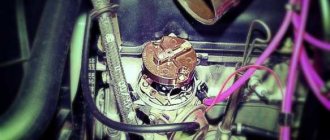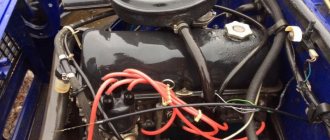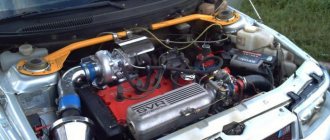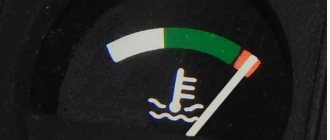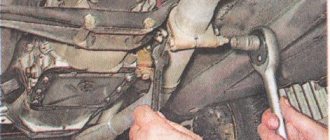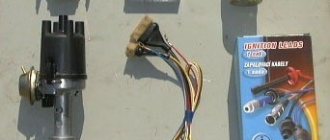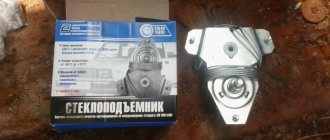Visual installation
A sample with a low-pressure turbine and a VAZ 2107 engine with distributed injection involves the use of the following factory parts: cylinder block, crankshaft, connecting rods, camshaft and valves.
The difference in additional components is associated only with the pistons and cylinder head due to the need to reduce the compression ratio during installation. This functional feature is achieved by enlarging the combustion chamber or special pistons. However, there is a theory that the pistons can be factory pistons and you can limit yourself to replacing the head. The injector output also differs. The turbine fills the space between the exhaust pipe and the exhaust manifold. The factory model remains the resonator and muffler. If you need to obtain more power, still use the recommendations for installing a direct-flow exhaust. Injection requires an enlarged receiver and a non-standard control program. The lubrication system also undergoes minor changes. Summarizing the above, we can conclude that the turbine itself will be the most expensive and scarce part.
Installation of a turbine (turbocharging) on VAZ cars
Why do you need a turbine for VAZ cars
? The answer to this question is that domestic cars don't have factory turbochargers? unlike foreign cars, and therefore have low power and dynamics compared to foreign cars.
First, you need to understand the principle of turbocharging, which is the injection of compressed air into the combustion chamber, which allows you to mix fuel with air faster, thereby increasing engine power.
The turbine itself is installed between the exhaust manifold and the exhaust pipe. The operation of the turbine is based on the use of exhaust gas energy, which is removed from the combustion chambers and rotates the turbine impeller with its entire flow, which is connected to a compressor that forces air into the engine cylinders. And the more fuel mixture is burned, the more exhaust gases are created, which put more pressure on the turbine, and so on.
The positive aspects of installing a turbo on a VAZ are:
- low weight of the turbocharger;
- the ability to adjust and configure the turbine for each car engine;
- installation of a turbo on a VAZ can be carried out both on a standard engine and on a tuning one;
- possibility of further tuning of the car;
- there is no need to increase the engine displacement;
- the ability to increase power without increasing engine speed;
- and a lot of other positive effects depending on the final goals.
Turbines for VAZ come in several types:
- Low pressure, the installation of which does not require major modifications to the car and is a more budget option. Very well suited for cars that are used in urban driving.
- High pressure, this type of turbocharger combined with boosting the engine, tuning the exhaust system, injection system and chip tuning can give a stunning effect. Mainly intended for fast driving enthusiasts or used on sports cars.
Installing a turbine on VAZ cars is the most effective way to increase power and give elastic dynamics compared to other types of tuning and boosting.
Our car service installs turbines of all types on VAZ cars: 2106, 2109, 2110, 2112, 2114, 2115 and others, based on your desires and the capabilities of the car engine.
Detailed information about costs and additional services can be found by phone or by mail
x
Turbine operating principle
We independently install electric windows on a VAZ 2107.
To increase engine power, you need to make the supply of the fuel-air mixture to the combustion chambers more intense. The turbine crashes into the exhaust system, is driven by a stream of exhaust gases and, using the energy of these gases, increases the pressure in the power unit. As a result, the rate of mixture entering the cylinders increases.
Under normal conditions, the VAZ 2107 engine has a gasoline combustion rate of about 25%. After installing a turbocharger, this figure increases noticeably and the engine efficiency increases.
Installing a turbine allows you to make the engine more powerful without increasing fuel consumption
Purpose of the turbine
The technical characteristics of the VAZ 2106 engine cannot be called outstanding. For this reason, many car enthusiasts are beginning to modify the engines of their “sixes” on their own. Installing a turbine on a VAZ 2106 engine is the most radical, but also the most effective way to increase engine performance.
A turbine is the most radical way to increase the power of a six engine.
By installing a turbine, the driver receives several advantages at once:
- the acceleration time of the car from standstill to 100 km/h is almost halved;
- engine power and efficiency increase;
- Fuel consumption remains virtually unchanged.
How does a car turbine work?
In short, the point of operation of any turbocharging system is to increase the rate of supply of the fuel mixture to the combustion chambers of the engine. The turbine is connected to the exhaust system of the “six”. A powerful stream of exhaust gas hits the impeller in the turbine. The impeller blades rotate and create excess pressure, which is pumped into the fuel supply system.
A car turbine directs exhaust gases into the fuel system
As a result, the speed of movement of the fuel mixture increases, and this mixture begins to burn much more intensely. The standard six engine has a fuel combustion coefficient of 26–28%. After installing a turbocharging system, this coefficient can increase to 40%, which increases the initial engine efficiency by almost a third.
Final result
How to set the ignition on a VAZ 2106 yourself
During the research, the turbine installed on the VAZ 2107 engine injector showed the following results: provided that the clutch and tires are of high quality, the acceleration time to 100 km/h is reduced by 5 seconds (compared to the base engine). The same principle applies to elasticity: acceleration time in 4th gear from 60 to 100 km/h is also reduced by 5 seconds.
Practical implementation
The idea itself is simple. However, it is difficult to implement it on the VAZ 2107. Representatives of companies that will undertake the production of turbochargers are counted on the fingers of one hand. But turbine kits for installation on a conventional injector began to appear on the market. The kit includes all the pipes, a new block cover, the turbine itself and the intercooler.
The difficulties of installation and further adaptation to the injector are as follows:
- The exhaust gas temperature level that the turbine must withstand is theoretically between 900˚C and 950˚C.
- The working speed of the rotor injector with the impeller is numerically represented not only in tens, but in hundreds of thousands of revolutions per minute.
- The functional resources of the volume of engine compartments of passenger cars are limited, and therefore require the manufacturer to place the unit within a specific framework.
Based on the above, a turbocharger must have high heat resistance, be compact, well-balanced, and at the same time inexpensive.
Elements of the turbocharging system
Any engine that is equipped with a turbocharger has a very good performance in terms of liter power and fuel consumption. That is, from a certain displacement of a supercharged engine, much greater specific power is removed than from a naturally aspirated engine. Due to the fact that a much larger amount of air passes through the turbine and through the intake manifold at a higher speed, the turbine itself heats up quite quickly and strongly. Therefore, an obligatory component of turbocharging is an intercooler - a cooling system for the charged air. The cooler the air is when it enters the combustion chamber, the more efficient the combustion process will be. This is, firstly, and secondly, if the cylinder head is severely overheated, there is a danger of detonation.
The main elements of the turbocharging system remain:
- turbine and intercooler;
- pressure control valve;
- a bypass valve that removes gases from the turbine if the throttle is closed;
- balancing valve, which allows you to relieve excess pressure;
- turbine housing;
- air and oil pipes.
Gas turbine
We independently change crankshaft oil seals on a VAZ 2106
Among the features of the turbine, one can highlight its rotation speed. It can reach 200 thousand rpm, and the pressure can reach up to 2 bar. This turbine can increase engine power by up to 50 percent. Turbine bearings rotate at enormous speeds and require lubrication. The system is connected to the lubrication system of the internal combustion engine. The turbine needs a certain time to gain the required speed. Therefore, it will start working only after three thousand revolutions. If you try to press the accelerator pedal sharply at low crankshaft speeds, the exhaust gas pressure will be too low for the unit to operate. You can feel the failures. This phenomenon is called nothing less than “turbo lag”.
What does turbocharging do for a car?
Since the VAZ 2106 is not equipped with a turbo system at the factory, like many modern foreign cars, all work to increase the car’s power will have to be done independently in a garage or by hiring a specialist. But it should be borne in mind that installing a turbine is quite a difficult task, and if you have no experience, you should seek help from professionals.
The operating principle of turbocharging is to pump treated and compressed air into the combustion chamber, which leads to mixing gasoline with air and increasing the power of the power unit. The turbine is usually located between the exhaust pipe and the intake manifold. The processed and released gases leaving the combustion chambers rotate a special turbine connected to a compressor. The last unit forces air into the cylinders. The quality of turbine operation directly depends on the amount of used gasoline.
Turbo kit for the "six"
Installing a turbine on a VAZ 2106 has its advantages:
- the turbocharger is fairly lightweight;
- the turbine can be adjusted for any car engine, for any carburetor;
- turbo can be installed on a motor that has undergone tuning;
- installation of the unit does not interfere with further modernization of the car;
- The turbine is suitable for an engine of any size.
There are 2 types of turbines. A low-pressure unit is a cheaper option, and its installation does not require major changes to the design of the car, which saves money. A high-pressure turbine involves tuning the main components of the machine and is expensive. To install this unit, you will have to redo the exhaust system, injection system and perform engine chip tuning. The car becomes sporty, sharp, agile and dynamic.
Turbine for VAZ 2106
Almost every car enthusiast of our time is trying to somehow modernize his car. People strive to improve the driving performance of a car almost immediately after purchasing it. For the same purpose, a turbine is installed on the VAZ 2106.
Increasing engine power is the main process of modifying a car. You can endlessly install pumped parts into the engine, but without installing a turbocharging system, the car will not become as powerful as we would like.
Installation of a turbine on a VAZ 2107
Installing a turbine allows you to double the power of the VAZ 2107 engine without increasing fuel consumption.
Reasons for installing a turbine on a VAZ 2107
Installing a turbine on a VAZ 2107 will allow:
- reduce vehicle acceleration time;
- reduce fuel consumption of injection engines;
- increase engine power.
Turbine operating principle
To increase engine power, you need to make the supply of the fuel-air mixture to the combustion chambers more intense. The turbine crashes into the exhaust system, is driven by a stream of exhaust gases and, using the energy of these gases, increases the pressure in the power unit. As a result, the rate of mixture entering the cylinders increases.
Under normal conditions, the VAZ 2107 engine has a gasoline combustion rate of about 25%. After installing a turbocharger, this figure increases noticeably and the engine efficiency increases.
Installing a turbine allows you to make the engine more powerful without increasing fuel consumption
Choosing a turbine for VAZ 2107
There are two types of turbines:
- low-performance (boost pressure 0.2–0.4 bar);
- high-performance (boost pressure 1 bar and above).
Installing a second type turbine will require a major engine upgrade. Installation of a low-performance device will ensure compliance with all parameters regulated by the automaker.
Before turbocharging the VAZ 2107 engine you will need:
- Intercooler installation. When using a turbine, the air heats up to 700°C. Without additional cooling, not only can the compressor burn out, but the engine itself can be damaged.
- Conversion of a carburetor fuel supply system to an injection system. A weak intake manifold on carburetor engines will not withstand the pressure of the turbine and may rupture. On units with a carburetor, you can install a compressor instead of full turbocharging.
In general, the advantages of the VAZ 2107 turbocharged engine are very doubtful. Therefore, before installing a turbine on a discontinued car with modest technical characteristics, you should carefully evaluate the feasibility of the decision being made. It is much easier to install a compressor on a VAZ 2107. In this case:
- there will be no excess pressure in the system that could destroy the manifold, car suspension, etc.;
- no need to install an intercooler;
- no need to convert the carburetor system to an injection system;
- the cost of re-equipment will be reduced - the complete compressor costs about 35 thousand rubles, which is much lower than the cost of the turbine;
- Engine power will increase by 50%.
I had to watch with my own eyes how a VAZ 2107 with a turbocharged engine rushes. It is difficult to overtake it on the highway, but the car cannot maintain speed for a long time, in my opinion, although I have not driven it myself.
Turbine installation
It is customary to install a turbine exclusively on engines with injection injection, but under certain conditions they mount a turbine on a VAZ 2106 carburetor model, which are prepared for such a technical action. It is known that the carburetor is not an ideal product from the point of view of supplying fuel for the operation of a turbo component for two reasons: the low level of supply and consumption of air masses to organize the interaction of these components and the lack of correspondence in the functionality of the turbo element with an intermediate cooler.
There are 2 ways to install a turbine on a carburetor VAZ 2106, in which interaction between these mechanisms will occur. The first is to place the air supply system in front of the turbocharger and direct the air-fuel mixture through all elements of the created circuit. The second is to mount a complex for increasing the supply of air mixture by placing the carburetor after the air blower.
Both methods of turbine installation have their advantages and disadvantages. However, when installing a complex for increasing the air mixture supply, you need to know that the efficiency of the power plant will be optimal at above-zero air temperatures. A distinctive feature of installing a turbine on a VAZ “sixth model” from tuning individual parts is the radical improvement of the car’s “engine”.
A suitable turbine is mounted together with other additional components, for example, a cooler that cools the air mixture. It is believed that the installation of a turbine should be entrusted to specialists, because this work requires the selection and adjustment of parts and their configuration, which only professional car mechanics can do. A special place is occupied by setting up engine systems after completion of work. Although you can see all this in the video, you can’t do it without special knowledge.
If you want to install a turbine on a VAZ 2106, the price will be very high and can reach significant amounts. Therefore, it is necessary to weigh all the pros and cons for carrying out such a technological operation.
Any car enthusiast wants the engine of his car to be as powerful as possible. Owners of the VAZ 2106 are no exception in this sense. There are many different ways to increase engine power and make your car go faster. But in this case, we will try to figure out only one method, which is called a turbine.
Suitable engines
The easiest way is to make a VAZ turbo based on a 16-valve unit. It has a fairly simple design and is therefore also easy to tune and maintain.
And most importantly, it is ideal for motorsports, as it can produce sufficient power at minimal cost.
Old engines equipped with a carburetor power system are practically not amenable to such tuning. But some craftsmen still build a turbo VAZ-2106. 8-valve injection engines would be suitable for civilian use, but in motorsport every horsepower is needed and important. Auto tuning experts recommend using 16-valve VAZ engines.
How is oil supplied to the turbine?
A complete turbocharging system cannot function without oil. So the driver who decides to install a turbine will have to solve this problem. When the turbine is installed, a special adapter is screwed to it (such adapters usually come complete with turbines). A heat dissipation shield is then installed on the intake manifold. Oil is supplied to the turbine through an adapter onto which a silicone tube is first placed. In addition, the turbine must be equipped with a cooler and an air tube through which air will flow into the manifold. Only in this way can an acceptable temperature of the oil supplied to the turbine be achieved. It should also be said here that sets of pipes and clamps for supplying oil to turbocharging systems can be found in spare parts stores.
A set of turbine pipes will save the driver a lot of time
This set costs from 1200 rubles. Despite the clearly inflated price, such a purchase will save the car owner a lot of time, since he will not have to bother with cutting and adjusting silicone tubes.
About the pipes
Pipes are needed not only for supplying oil. Exhaust gases from the turbine also need to be removed. To remove excess gas not used by the turbine, a massive silicone pipe on steel clamps is used. In some cases, a whole system of silicone pipes is used to remove the exhaust (their number is determined by the design of the turbine). Usually there are two of them, in some cases - four. Before installation, the pipes are carefully inspected for internal contamination. Any, even the smallest, speck that gets into the turbine can cause a breakdown. It is for this reason that each pipe is thoroughly wiped from the inside with a cloth soaked in kerosene.
Exhaust pipes are usually made of silicone
When choosing clamps for pipes, you should remember: silicone is not a very durable material. And if, when installing the pipe, you tighten the steel clamp too much, it can simply cut the pipe. For this reason, experienced motorists recommend not using steel clamps at all, but instead using clamps made of special high-temperature plastic. It provides reliable fastening and does not cut the silicone.
Where to begin?
Not every car is suitable for tuning
It is important to pay attention to the condition of the car. It is better to disassemble the car to the ground. The main problem is corrosion
You need to understand that the metal on AvtoVAZ cars is quite thin, and high loads are contraindicated for it. If you apply a serious load, the rusty metal will literally tear
The main problem is corrosion. You need to understand that the metal on AvtoVAZ cars is quite thin, and high loads are contraindicated for it. If you apply a serious load, the rusty metal will literally tear.
You should start by replacing the metal in the engine compartment with a more powerful one. When all body faults have been repaired, you can continue tuning further. If the car was purchased specifically for tuning, then the first thing you need to do is get it moving in stock condition. Next, they change the electrical wiring, bring the engine into good condition, or change it to a sixteen-valve one. The brake system and transmission are also inspected.
This is the first point from which the instructions for turbocharging begin. When the iron has returned to an ideal, close to factory condition, you can continue further. Moreover, we already know enough about turbocharging equipment.
What you need to know about supercharging
Turbocharging is the forced injection of air into the combustion chambers by creating a high-pressure zone at the inlet of the intake tract. When the driver of the car presses the pedal and the throttle valve opens, significantly more air will enter the intake manifold than if it were supplied at atmospheric pressure. As the amount of oxygen increases, the carburetor or injector also increases the amount of fuel. Due to this, the engine power increases.
The combustion chamber has a fixed size, and its volume is a constant value. On a standard engine, only a limited amount of the fuel mixture fits into it. To increase power, it is necessary to place a larger volume of fuel in the cylinder. This is achieved by creating high pressure, which will compress the mixture. Then it will take up less space. This is why turbocharging is needed.
What is boost
The moment came when the engineers realized that there was nowhere to increase the volume of engines any further. Its mass often exceeded the mass of the car itself, and this required additional horsepower, and so on ad infinitum. It was then that they decided that it was necessary to increase power not by the volume of the cylinder, that is, the combustion chamber, but by its filling with the combustible fuel-air mixture. The technical opportunity to implement all this appeared already in 1910, but the paths to implementation diverged. It is clear that in order to force the mixture into the combustion chamber in greater quantities, forced air pressure is necessary. Then they began to use atmospheric supercharging.
This is a kind of pipe system of different sections into which oncoming air enters while the car is moving. Due to the geometry and changes in pipe sections, the pressure increased and the filling of the combustion chamber with a mixture of air and fuel improved. As a result, power also increased. But this was not enough, therefore, a little later mechanical supercharging appeared. Its design was an air compressor driven by an internal combustion engine, usually using a pulley and a V-belt.
This system is still in use today, but even later it was transformed into a completely different Roots-type supercharger. This is a completely different story and we won’t touch it today. Mechanics are mechanics, but in 1905 Alfred Büchi invented and patented a completely new type of supercharging, which revolutionized the concept of internal combustion engine power. With its help, Büchi increased engine power by 120%, and the device was called turbocharging.
8-valve engine kit
The turbo kit for the 8-valve engine has the following characteristics. It is capable of generating pressure up to 0.5 Bar. With this kit you can increase power to 120 horsepower and torque to 190 Nm. Installing this kit does not affect the life of the power unit in any way. Installation is quite simple, and all parts from the kit are hinged. There is no need to modify the engine in any way for installation.
The turbo kit includes:
- Steel manifold.
- Turbocharger.
- Gaskets.
- Oil supply hose.
- Coolant supply system.
- Valve for releasing excess pressure.
- Connecting elements.
- Fasteners and other parts.
The set for 16-valve units is completely similar. Its technical characteristics are also similar. On sale you can find a turbo kit for an 8-valve engine with a power of up to 250 horsepower. A turbocharger with a pressure of 1 bar is used here.
Installation of a turbocharging system
There are two methods for installing turbines on the “six”:
- connection to the collector;
- connection to the carburetor;
The vast majority of drivers are inclined towards the second option, since there is less hassle with it. In addition, in the case of a carburetor connection, the fuel mixture is formed directly, bypassing the manifold. To establish this connection, you will need the following things:
- spanners included;
- flat screwdriver;
- two empty containers for draining antifreeze and lubricant.
Sequence of connecting a full-fledged turbine
First of all, it should be said that a turbine is a rather large device. Therefore, it will require space in the engine compartment. Since space is limited, many 6 owners install turbines where the battery is installed. The battery itself is removed from under the hood and installed in the trunk. It should be noted here that the sequence of connecting the turbocharging system depends on what type of engine is installed on the “six”. If the car owner has the earliest version of the “six”, then a new intake manifold will have to be installed on it, since the standard one will not be able to work with the turbine. Only after these preparatory operations can you proceed directly to installing the turbocharging system.
- First, the additional intake duct is installed.
- The exhaust manifold is removed. A small section of air pipe is installed in its place.
- Now the air filter is removed along with the generator.
- Antifreeze is drained from the main radiator (before draining, an empty container should be placed under the radiator).
- The hose that connects the engine to the cooling system is disconnected.
- The lubricant is drained into a previously prepared container.
- A hole is drilled on the engine cover using an electric drill. A thread is cut into it using a tap, after which a cross-shaped adapter is installed in this hole.
- The oil sensor is unscrewed.
- The turbine is connected to a previously installed air pipe.
Compressor connection sequence
It was mentioned above that connecting a full-fledged turbocharging system to an old “six” may not always be justified, and that installing a conventional compressor may be a more acceptable option for many drivers. So it makes sense to analyze the installation sequence of this device.
- The old air filter is removed from the inlet air pipe. A new one is installed in its place; the resistance of this filter should be zero.
- Now take a piece of special wire (it usually comes with the compressor). One end of this wire is screwed to the fitting on the carburetor, the other end is attached to the air outlet pipe on the compressor. Steel clamps from the kit are usually used as fasteners.
- The turbocharger itself is installed next to the distributor (there is enough space there, so a medium-sized compressor can be installed without problems).
- Almost all modern compressors come complete with mounting brackets. These brackets are used to attach the compressor to the cylinder block.
- After installing the compressor, it is not possible to install a standard air filter. Therefore, instead of filters in standard housings, drivers install special boxes made of plastic. Such a box serves as a kind of adapter when pumping air. Moreover, the tighter the box, the more efficient the compressor will work.
- Now a new filter is installed on the suction tube, the resistance of which tends to zero.
This sequence is the simplest and at the same time the most effective when installing a turbocharger on all VAZ “classics”. While installing this system, the driver himself can look for new ways to improve the tightness of the box and pipe connections. Many people use regular high-temperature sealant for this, which can be found at any auto parts store.
About the choice of turbocharging systems
Currently, car enthusiasts do not need to design turbines themselves, since a wide range of ready-made systems are available on the aftermarket. But with such abundance, the question will inevitably arise: which system to choose? To answer this question, the driver must decide how much he is going to modify the engine, i.e. how deep the modernization will be. Having decided on the degree of intervention in the engine, you can move on to turbines, which come in two types:
- reduced power turbines. These devices rarely generate pressure above 0.6 bar. Most often it varies from 0.3 to 0.5 bar. Installing a low-power turbine does not involve serious intervention in the engine design. But they also provide an insignificant increase in productivity - 15–18%.
- powerful turbocharging systems. Such a system is capable of creating a pressure of 1.2 bar or more. To install it in the engine, the driver will have to seriously upgrade the engine. In this case, the engine parameters may change, and not necessarily for the better (this especially applies to the CO level in the exhaust gas). However, engine power can increase by a third.
What is meant by modernization
Before it comes to installing the turbine, the driver will have to carry out a number of preparatory procedures:
- cooler installation. This is a device for cooling air. Since the turbocharging system runs on hot exhaust gas, it gradually heats up. Its temperature can reach 800°C. If the turbine is not cooled in a timely manner, it will simply burn out. In addition, the engine may also be damaged. So you can’t do without an additional cooling system;
- The carburetor “six” will have to be converted into an injection engine. The intake manifolds of the old carburetor “sixes” were never particularly durable. After installing the turbine, the pressure in such a manifold increases approximately five times, after which it ruptures.
All of the above points indicate that installing a turbine on an old carburetor six is, to put it mildly, a questionable decision. It would be much more advisable for the owner of such a car to install a turbocharger on it.
In some cases, it is more advisable to install a turbocharger instead of a turbine
This solution has several advantages:
- the driver will no longer worry about the problem of high pressure in the intake manifold;
- there is no need to install additional cooling systems;
- there will be no need to redo the fuel supply system;
- installing a compressor costs half as much as installing a full-fledged turbine;
- Motor power will increase by 30%.
Choosing a turbine for VAZ 2107
There are two types of turbines:
- low-performance (boost pressure 0.2–0.4 bar);
- high-performance (boost pressure 1 bar and above).
Installing a second type turbine will require a major engine upgrade. Installation of a low-performance device will ensure compliance with all parameters regulated by the automaker.
Before turbocharging the VAZ 2107 engine you will need:
- Intercooler installation. When using a turbine, the air heats up to 700°C. Without additional cooling, not only can the compressor burn out, but the engine itself can be damaged.
- Conversion of a carburetor fuel supply system to an injection system. A weak intake manifold on carburetor engines will not withstand the pressure of the turbine and may rupture. On units with a carburetor, you can install a compressor instead of full turbocharging.
In general, the advantages of the VAZ 2107 turbocharged engine are very doubtful. Therefore, before installing a turbine on a discontinued car with modest technical characteristics, you should carefully evaluate the feasibility of the decision being made. It is much easier to install a compressor on a VAZ 2107. In this case:
- there will be no excess pressure in the system that could destroy the manifold, car suspension, etc.;
- no need to install an intercooler;
- no need to convert the carburetor system to an injection system;
- the cost of re-equipment will be reduced - the complete compressor costs about 35 thousand rubles, which is much lower than the cost of the turbine;
- Engine power will increase by 50%. Installing a compressor on a VAZ 2107 is much simpler, safer and more profitable than installing a full-fledged turbine
I had to watch with my own eyes how a VAZ 2107 with a turbocharged engine rushes. It is difficult to overtake it on the highway, but the car cannot maintain speed for a long time, in my opinion, although I have not driven it myself.
About connecting turbines to the injector
It is much more expedient to install a turbocharging system on an injection engine than on a carburetor one. Fuel consumption becomes lower and engine performance improves. This primarily relates to environmental parameters. They improve because about a quarter of the exhaust is not released into the environment. In addition, motor vibration will be reduced. The sequence of connecting the turbine to injection engines has already been described in detail above, so there is no point in repeating it. But something still needs to be added. Some owners of injection cars try to further increase the turbo boost. To achieve this, they disassemble the turbine, find a so-called actuator in it and install a reinforced spring under it instead of the standard one. Several tubes are connected to the solenoids in the turbine. These tubes are silenced, but the solenoid remains connected to its connector. All these measures lead to an increase in the pressure created by the turbine by 15–20%.
Pros and cons of turbine, compressor and naturally aspirated engine
Let's consider all these methods of engine tuning separately.
Turbine
Under the hood of a turbocharged VAZ-2112
In recent years, the installation of turbines on cars of the VAZ family has become quite widespread. And there is nothing unexpected about this, since they are the most common, unlike mechanical inflation (compressor - approx.), because they have a number of advantages.
Firstly, the supercharger is located next to the turbine impeller and is built into the exhaust manifold, driving itself with exhaust gases. Secondly, such an arrangement of components can significantly increase the efficiency of the entire engine, because there is no direct connection between the turbine and the crankshaft, since it does not take power from the engine itself. Experienced auto mechanics call this the main advantage of a turbine over a compressor.
Turbine disadvantages
However, the turbine has its drawbacks, and these include “turbo lag”. This effect manifests itself in a slow response to pressing the gas pedal, and at low speeds the turbine operation will not be felt at all. The explanation for this is very simple: in order for the engine to begin to gain power and speed, it requires time for the exhaust gas pressure to increase, which would be able to properly spin the turbine. For exactly the same reason, a turbocharged engine is capable of producing maximum power only after 4000 rpm.
Compressor
The compressor engine starts air movement due to a special mechanical supercharger operating using a belt drive. That is, the operation and power of the engine directly depends on the number of revolutions gained and the higher they are, the higher the power. In the design of the compressor, the air mixture with fuel is not only supplied to the cylinders under pressure, but is also capable of blowing through the exhaust and intake valves when they are not completely closed, thereby cleaning them. Because of this design, the engine is always able to operate at full power.
Disadvantages of the compressor
A significant disadvantage of such a modification is the unreliability of the drive belts, which will one way or another break and become unusable, as well as increased fuel consumption, since the compressor is best installed on engines with a large volume, since the efficiency of interaction with them will be much higher.
Atmospheric engine
When talking about an atmospheric engine, many people think of anything but what actually exists.
The atmospheric engine is both simple and the most complex in its design. Since the ideal fuel-air mixture is supplied to the cylinders of this engine, without any obstacles or resistance in its path. The manifold works perfectly on this engine, the camshaft is adjusted as precisely as possible, the cylinder diameter, piston stroke, and so on are increased. And all this is done to increase the rated power of the engine.
Despite the fact that this is a seemingly ideally built engine, the advantages of which include the strictly accurate response of the gas pedal and a good reserve of power at any speed, it also has disadvantages in comparison with its turbocharged counterpart.
Cons of a naturally aspirated engine
- The first disadvantage due to which you can give preference to the “turbo” is the very high fuel consumption and the high degree of wear of the internal parts of the engine. It is also impossible for a naturally aspirated engine to more than double the stock power, whereas a turbocharged engine can increase it several times.
- Heavily promoted “aspirated” engines only drive at high speeds, which has a negative effect when driving in urban conditions. They also have a high idle threshold, which is also inconvenient for everyday use.
A little theory
The most effective way to make such improvements is for those who have a clear understanding of their actions. To do this, you need to understand the theoretical part.
So, a car’s power and fuel consumption depend on the quality and degree of enrichment of the fuel-air mixture entering the cylinders, as well as on its volume.
Of course, the volume of the burned mixture can be increased by increasing the combustion chamber, as well as increasing the number of cylinders. However, this will not bring optimal results, since the engine becomes large and heavy, and fuel consumption increases significantly. Turbocharging solves this problem.
The fact is that a conventional engine, when operating, pumps air into itself due to the vacuum created by the piston. In a turbocharged power unit, this work is performed by a turbocharger. In this case, the air is pre-compressed, which allows you to pump in a larger volume. That is, it is possible to burn a larger volume of fuel. The result is an increase in engine power in relation to engine volume and fuel consumed.
One important point: air, as you know, heats up when strongly compressed. It will heat up again when compressed in the combustion chamber. In this case, detonation may occur. And, in addition, due to heating, the air density in the cylinder will decrease, which will naturally reduce the efficiency of the entire system. To remove these negative phenomena, intercoolers are used - air coolers from the turbine. They are a radiator.
Typically, turbochargers were installed on engines with electronic fuel injection (gasoline or diesel), and mechanical compressors on carburetor internal combustion engines. In this case, a turbine can also be installed on a carburetor engine, but additional difficulties arise, which will be discussed a little later.
As already mentioned, there are two types of compressors:
- A turbocharger that operates by using the energy of exhaust gases. Exhaust gases enter the impeller and rotate it, due to which air is pumped;
- Mechanically driven compressor. It is powered by a motor drive. At the same time, efficiency decreases and fuel consumption increases compared to the first version of the compressor, since the mechanical supercharger takes away part of the power from the internal combustion engine.
The entire system, in addition to the turbine itself, includes several more important components that must be remembered during installation:
- a control valve that maintains a given pressure;
- a bypass valve that allows compressed air to return back to the compressor inlet pipes if the engine throttle valve is closed;
- a bleed valve that releases compressed air into the atmosphere when the throttle valve is closed;
- air pipes;
- oil pipes (serve for lubrication and cooling of the turbine).
Setting up the turbine operation
A simple electric turbine on a VAZ can increase power, but only slightly. The use of mechanical turbochargers will be much more effective. The turbo engine is tuned using a wastegate. The pressure in the fuel system will be greater, the less it is released into the atmosphere. It is advisable to use special designs of boost controllers to adjust the pressure level.
View gallery
Using this simple device, you can set the required pressure directly from inside the car. With its help, the safety valve installed on the manifold does not relieve pressure. Therefore it is gradually growing.
It is imperative to “reflash” the electronic control unit, since the operating modes of the engine will change significantly. It is advisable to entrust this work to experienced specialists, otherwise improper operation of the engine will affect not only the power, but also the consumption of gasoline and oil. In addition, all engine components can wear out hundreds of times faster than with normal settings.
The price of a turbo kit and what is included in it
The kit includes the following elements:
- Mitsubishi turbine compressor 16 g style;
- turbine 16 valve manifold Subaru;
- 8 nuts m 10*1.25;
- 2 screws m 10*30*1.25;
- 3 studs;
- vin banjo;
- budget receiving tube;
- oil supply tube 500 mm long;
- bolt for removing the oil substance from the cylinder head and entering the turbine compressor;
- 2 copper washers 10 mm;
- 6 copper washers 14 mm;
- 2 antifreeze supply tubes;
- kit for draining oil substance from the turbine;
- piping with silicone;
- two clamps 25*40;
- receiver;
- device for measuring and recording the temperature of air masses;
- wire harness;
- 4 Bosch fuel injectors;
- silver fuel pump 220 liters;
- 4 turbine pistons 82 mm;
- 4 piston rings 82 mm;
- motor gaskets;
- oil pan gasket;
- nut 6 with skirt;
- blue vacuum tube.
The installation price for a motor with the specified characteristics is 61,000 - 68,000 rubles. If you contact a hotel for installation, you will have to pay about 20,000 - 26,000 rubles for the work. Also, additional costs will be required for modifications to systems and components.
Difficulties may arise during the system installation process. Mechanics recommend moving the entire structure slightly to the right side. In this way, overheating of the turbine and collector can be avoided. If you notice that the installed receiver affects the radiator surround, you need to increase the length of the intake valves. This will move the receiver further away from the radiator.
When planning to tune the engine of a Lada Priora, analyze all the pros and cons. Choose the right kit carefully. Formulate the requirements for the characteristics you want to obtain after modernization. Select the necessary kit to install the turbine, taking into account the characteristics of the motor. If the car participates in long-distance racing or drifting, installing a turbo on the Lada Priora will significantly increase power and other characteristics. When driving a car only within the city, the engine will behave worse than before tuning.
Installation
It must be remembered that equipping an engine with a turbocharging system is a rather lengthy process. Although kit manufacturers say that you can do without upgrading the engine, this is not entirely true. Where to begin? Of course, with the purchase of the necessary spare parts and preparation of the engine. It is necessary to replace the pistons, rings, cylinder head gasket, fuel regulator, throttle, as well as pipes and other parts. All these mechanisms must be as reliable as possible.
You also need to remember that building a powerful car can vary significantly depending on the turbine model. The instructions will be quite average. For example, in order to build a turbo VAZ-2106, you first need to replace the engine.
It is necessary to install a 16-valve injection unit. The first step is to prepare the engine. The engine is disassembled, the cylinders, crankshaft, connecting rods, and oil pump are checked. If necessary, grind the block. Pistons should be purchased after the cylinders have been prepared.
Next, the attachments are assembled. At this stage, the injectors are installed and the fuel pump is changed. Then a receiver and exhaust manifold are installed and a turbine is used. All steel elements are also installed. And finally, the last stage is setup. The maximum power, torque and other characteristics of the motor will depend on how professionally and correctly the adjustment is performed. If all the operations for preparing and assembling the system can be done with your own hands, then for setup it is better to turn to professionals (especially if the VAZ is a turbo on gas). By the way, there is now a lot of controversy about whether it is possible to install an LPG on a “turbo”. Experts say that the octane number of such a mixture is more than 102. Therefore, gas will not harm the operation of such a power unit.


